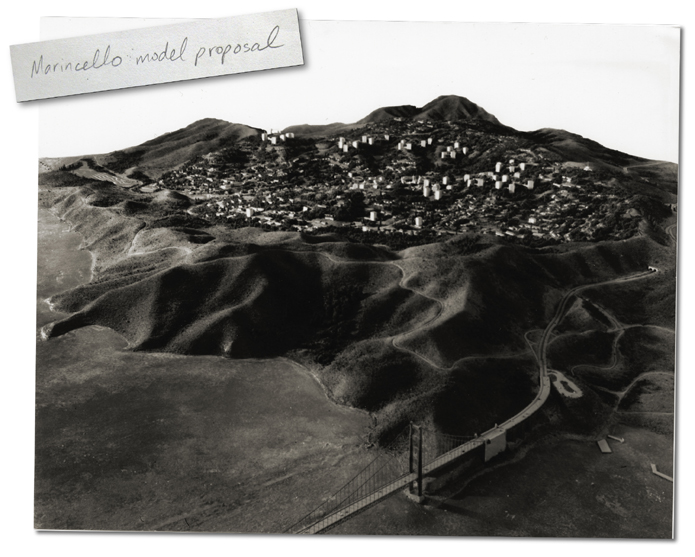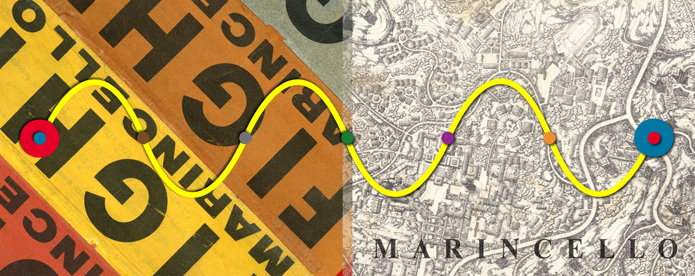| |
 |
 |
 |
|
marincello unsoundwalk
|
 |
|
| Increasingly forgotten by contemporary residents of the San Francisco Bay, Marincello, California, was a planned community of 35,000 that came close to dominating the Marin Headlands in the mid-60's.
Though fading from view, the city that isn't very nearly was.
Marincello was a large scale development project proposed by East Coast developer Thomas Frouge, bankrolled by Gulf Oil, and approved by local government using tactics that silenced dissent. Construction began, the city's gates were christened, and a few key access roads were graded.
Amid fierce public resistance, managed in large part by a local artist named Katharine Frankforter, however, development stalled. Marincello was ultimately blocked by its opponents after a chance but crucial blow: the untimely death of Thomas Frouge.
The land the city would have occupied eventually became part of the Golden Gate National Recreation Area. Today, the Marincello site is the center of a much-beloved and much-visited set of rugged open hills framing the Golden Gate north of San Francisco.
By some accounts, the collapse of Marincello and the subsequent preservation of the open space it would have occupied galvanized the nascent ecological movement in the United States.

|
|
marincello unsoundwalk
rodeo soundial
handpans and the hang
as paredes têm ouvidos
flostam resonance #1
a day, a week, a year
field
effects concert series
annapurna: memories
in sound
quiet, please
serendipity
machines
kolam
urban
cycles
other recordings |
| 
Three-dimensional architectural model of Marincello, as photographed in the early 60's; the model is now being renovated by the National Park Service.
| While an artist in residence at the Headlands Center for the Arts in the Rodeo Valley in the fall of 2009, my studio windows opened onto a view of a hillside that would have been home to tens of thousands. The path I took along the lagoon to Rodeo Beach might have been a rerouted Highway One.
Living amid the nearly-was, I researched the vanishing history of Marincello as it has been captured in the archives of the GGNRA and produced Marincello Unsoundwalk: a sixty-five-page full-color book and trail guide constructed with archival and public materials.
The project originated in my perpetual desire to make work about, and with, the materials and landscape I am in. Even before arriving as a Headlands resident, I was fascinated by the fact that so many long-time Bay Area residents — admittedly, a population of transients and newcomers such as myself — were unaware of the city that almost consumed the undeveloped hills we take for granted.
The project's realization, however, was a very new direction for me.
In recent years I have become increasingly interested in new ways of working with and through documentary sound. With Marincello, I had what seemed a novel task: to explore something that was not, rather than was, there,
In Marincello Unsoundwalk, traces remain of the kind of meticulous site-specific recordings found on this site—in this case, of binaural recordings made in and around the Golden Gate Recreation Area during my residency.
But in this project what remains are truly only traces: rather than share my recordings— themselves mere proxies for soundscapes that never came to be — conventionally, instead I listened to them very closely many times, rendered what I heard concisely into text, and erased them forever at the culmination of a public artist talk at Headlands. The project is thus centered not around sound, but un-sound.
Using text to document specific sonic experience, I hoped to evoke the imagined soundscape of an imagined city not through a conventional reconstruction or synthesis of it, but through confabulation alone.
As one reads, and imagines, the soundscape of Marincello for a moment lives... then fades, lost again to some alternate timeline.
| | 
LEFT: Thomas Frouge and the Frouge Corporation. RIGHT: Katharine Frankforter. CENTER: Route of the Marincello Unsoundwalk juxtaposed over competing visions of the future of the Gerbode Valley, a NPS trail map and the Marincello master plan. The Headlands Center for the Arts is located near the trailhead at the Marin Headlands Visitor Center. |
Marincello's collapse is not a one-dimensional story of good triumphing over evil.
As originally conceived, Marincello was fairly progressive even by modern standards. Much of the housing was open-plan and well-integrated into the landscape. More intruigingly, great emphasis was initially placed on pedestrian traffic; pathways were proposed to seemlessly integrate into a trail system in proposed state parkland surrounding the city. And Marincello was designed as complete city, not just a residential suburb; it featured commercial and recreational fascilities and a light indiustrial zone to limit driving.
Its defeat had personal consequences as well: as someone most likely priced forever out of owning a home in San Francisco in which to raise my own family, I can't argue with the need for affordable housing nearby.
I see this story instead as a contest between competing visions, and in a narrative way, between opposed wills: that of a developer and that of an artist.
Both Thomas Frouge and Katharine Frankforter were visionaries, and both were skilled at playing the game in a multidimensional way. Both are worthy of our memory and respect.
My project is dedicated to them both.
|
|

Cover of Marincello Unsoundwalk, which is designed to be read in both orientations: after reading the first half, the book is flipped over and upside down.
|
|
Marincello Unsoundwalk, the book, is not meant to be read and forgotten; but acted upon and written in. Only when you walk the hills and fill in its blank spaces yourself is the work the book embodies complete.
The book is not itself a 'work of art,' but a catalyst for one: the experience of moving through the Marincello site yourself. In addition to being a visual summary of archived history, it is a trail guide for a walk you are meant to take..
The walk described takes about three hours, including numerous stops for listening and journalling on both the ascent and descent. There is a moderate climb involved, but the trail is a wide well-graded fire road, so if conditions allow the hike is wheelchair and stroller friendly (indeed, I pushed my daughter to the ridgetop several times).
Copies of Marincello Unsoundwalk are available from me directly during a guided walk, or at lulu.com (I do a small amount of post-production work to copies available through me).
If you are in the Bay Area, a private facilitation can be arranged; write me.
Special thanks to Amanda Williford at the GGNRA Park Archives and Record Center, without whose cheerful assistance and deep knowledge my book might never have been written; and everyone at the Headlands Center for the Arts.
| |
| |
|  |
|

